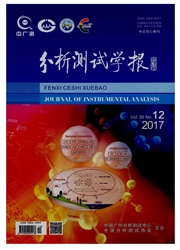

 中文摘要:
中文摘要:
体外分离人外周血CD8^+T细胞,用植物凝结素(PHA)刺激活化,利用原子力显微镜(AFM)观察CD8^+T细胞的形貌,并结合针尖修饰技术对力谱进行分析,确定了CD8抗原分子的分布。结果表明,与静息的CD8+T细胞相比,活化后的CD8^+T细胞直径和高度增大,细胞表面变得更粗糙;CD8抗原-抗体的相互作用力大约是非特异性黏附力的5倍,活化后的CD8^+T细胞上特异性黏附力(即CD8抗原分子位置)分布不均匀,其表面的CD8抗原分子分布以纳米团簇分布为主,CD8分子聚集更为明显,CD8^+T细胞上CD8抗原-抗体相互作用力不随着活化而发生明显变化,说明CD8抗原-抗体之间具有高选择性。原子力显微镜为特异性T细胞的抗原识别和活化研究提供了一种新手段,能够使T细胞抗原识别和活化的机制得到更好地阐明。
 英文摘要:
英文摘要:
In this study, CD8^+ T cells were firstly isolated from human peripheral blood in vitro and activated by phytohaemagglutinin(PHA). Morphology of cells was observed by atomic force microscopy (AFM) and distribution of CD8 antigen molecules of CD8 ^+ T cells were studied by a functionalized AFM tip. Laser confocal scanning microscope(LCSM) experiment showed that the CD8 antigen mole- cules were distributed over the CD8^+ T cells, and the AFM experiment showed that comparing to resting CD8 ^+ T cells, the diameter and height of activated CD8^+ T cells became large, the ultrastructure of the cells became complex; the strength of the specific binding force of the CD8 antigen-antibody interaction was found to be approximately four times bigger than that of the unspecific force. The CD8 antigen molecules were not randomly distributed over the surface of a single activated CD8^+ T cell, they were formed into nanometer domain, the CD8 molecules were gathered obviously. The force of CD8 antigen-antibody interaction of CD8^ + T cell did not changed significantly when CD8^ + T cells were activated, these results suggest that CD8 antigen-antibody interaction is highly selected and high affinity. Atomic force microscopy can provide a new tool to study the specificity T cell antigen recognition and activation, it makes us to better clarify the T cell antigen recognition and activation mechanism.
 同期刊论文项目
同期刊论文项目
 同项目期刊论文
同项目期刊论文
 Photoinactivation effects of hematoporphyrin monomethyl ether on Gram-positive and -negative bacteri
Photoinactivation effects of hematoporphyrin monomethyl ether on Gram-positive and -negative bacteri Atomic Force Microscope-Related Study Membrane-Associated Cytotoxicity in Human Pterygium Fibroblast
Atomic Force Microscope-Related Study Membrane-Associated Cytotoxicity in Human Pterygium Fibroblast Sonodynamic Effects of Hematoporphyrin Monomethyl Ether on CNE-2 Cells Detected by Atomic Force Micr
Sonodynamic Effects of Hematoporphyrin Monomethyl Ether on CNE-2 Cells Detected by Atomic Force Micr Detection of erythrocytes in patient with elliptocytosis complicating ITP using atomic force microsc
Detection of erythrocytes in patient with elliptocytosis complicating ITP using atomic force microsc Curcumin induced nanoscale CD44 molecular redistribution and antigen-antibody interaction on HepG2 c
Curcumin induced nanoscale CD44 molecular redistribution and antigen-antibody interaction on HepG2 c An easy method to detect the kinetics of CD44 antibody and its receptors on B16 cells using atomic f
An easy method to detect the kinetics of CD44 antibody and its receptors on B16 cells using atomic f AFM- and NSOM-based force spectroscopy and distribution analysis of CD69 molecules on human CD4(+) T
AFM- and NSOM-based force spectroscopy and distribution analysis of CD69 molecules on human CD4(+) T Cold Induces Micro- and Nano-Scale Reorganization of Lipid Raft Markers at Mounds of T-Cell Membrane
Cold Induces Micro- and Nano-Scale Reorganization of Lipid Raft Markers at Mounds of T-Cell Membrane Nanostructure and nanomechanics analysis of lymphocyte using AFM: From resting, activated to apoptos
Nanostructure and nanomechanics analysis of lymphocyte using AFM: From resting, activated to apoptos NSOM- and AFM-based nanotechnology elucidates nano-structural and atomic-force features of a Y-pesti
NSOM- and AFM-based nanotechnology elucidates nano-structural and atomic-force features of a Y-pesti Label-free oligonucleotide detection method based on a new L-cysteine-dihydroartemisinin complex ele
Label-free oligonucleotide detection method based on a new L-cysteine-dihydroartemisinin complex ele Connection between biomechanics and cytoskeleton structure of lymphocyte and Jurkat cells: An AFM st
Connection between biomechanics and cytoskeleton structure of lymphocyte and Jurkat cells: An AFM st Electrochemical activity of holotransferrin and its electrocatalysis-mediated process of artemisinin
Electrochemical activity of holotransferrin and its electrocatalysis-mediated process of artemisinin 期刊信息
期刊信息
